Abstract
This review discusses recent literature on the chemical and physiological factors that influence the absorption, distribution, and excretion of aluminum in mammals, with particular regard to gastrointestinal absorption and speciation in plasma. Humans encounter aluminum, a ubiquitous yet highly insoluble element in most forms, in foods, drinking water, and pharmaceuticals. Exposure also occurs by inhalation of dust and aerosols, particularly in occupational settings. Absorption from the gut depends largely on pH and the presence of complexing ligands, particularly carboxylic acids, with which the metal can form absorbable neutral aluminum species. Uremic animals and humans experience higher than normal body burdens of aluminum despite increased urinary clearance of the metal. In plasma, 80-90% of aluminum binds to transferrin, an iron-transport protein for which receptors exist in many tissue. The remaining fraction of plasma aluminum takes the form of small-molecule hydroxy species and small complexes with carboxylic acids, phosphate, and, to a much lesser degree, amino acids. Most of these species have not been observed in vivo but are predicted from equilibrium models derived from potentiometric methods and NMR investigations. These models predict that the major small-molecule aluminum species under plasma conditions are charged and hence unavailable for uptake into tissues.
Full text
PDF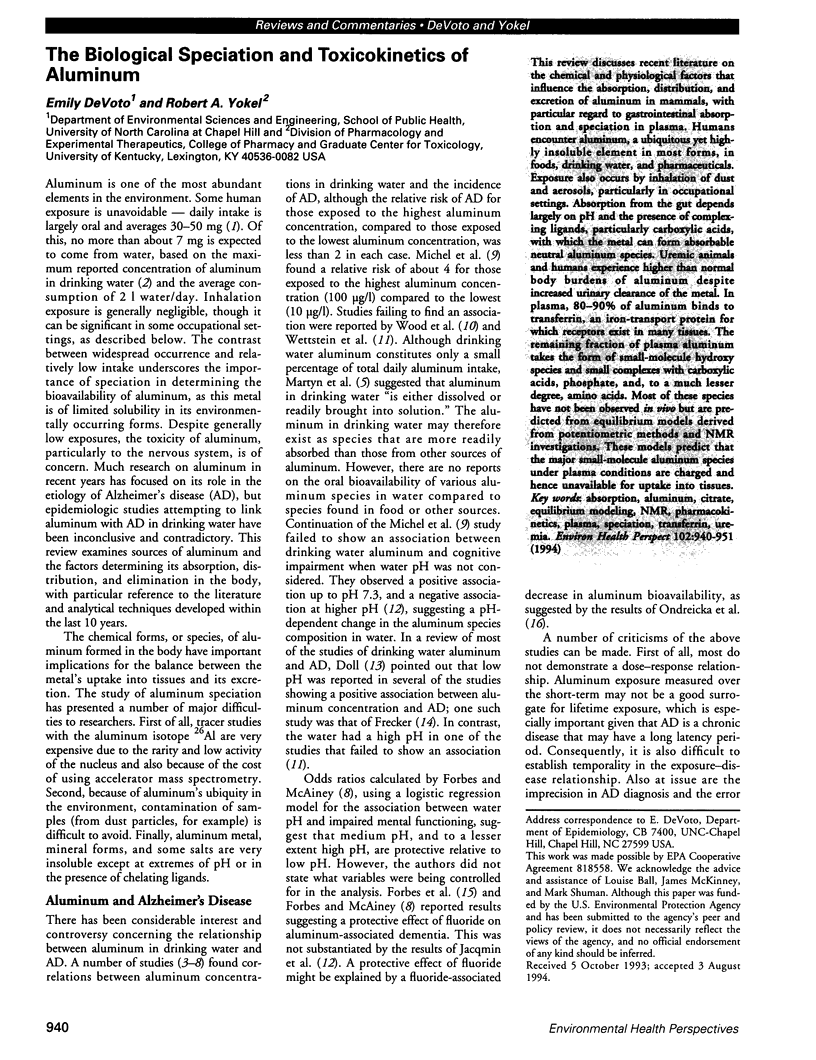
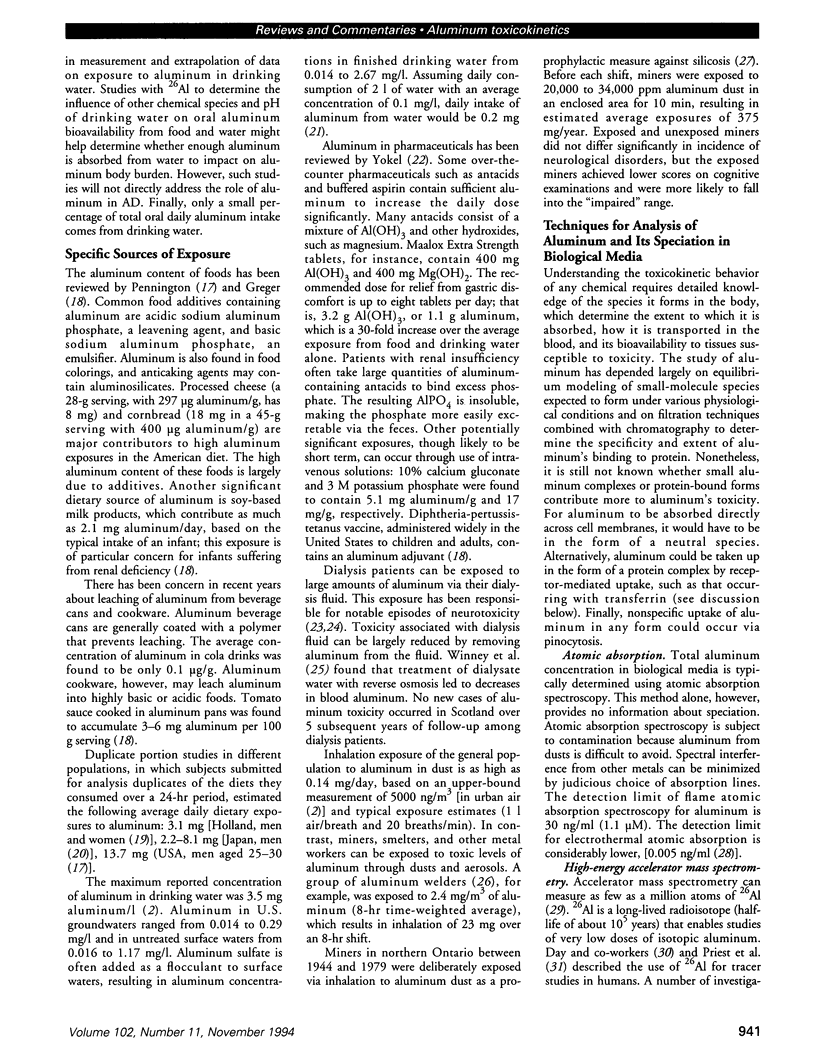

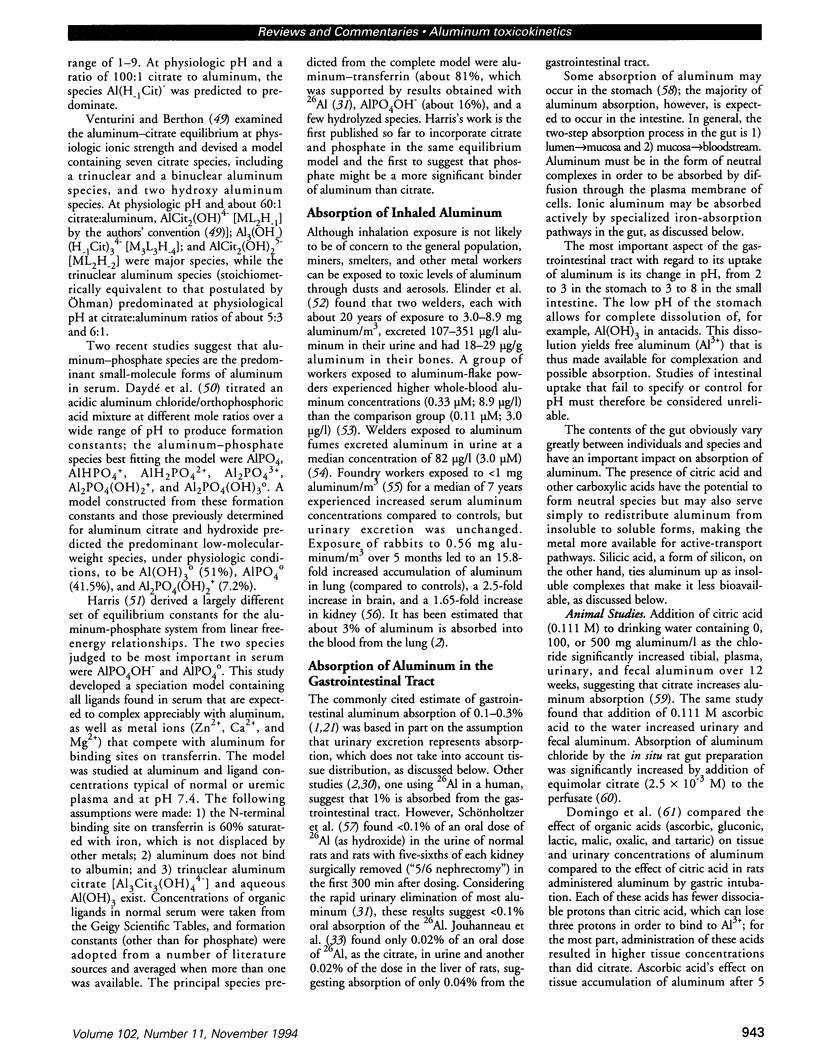
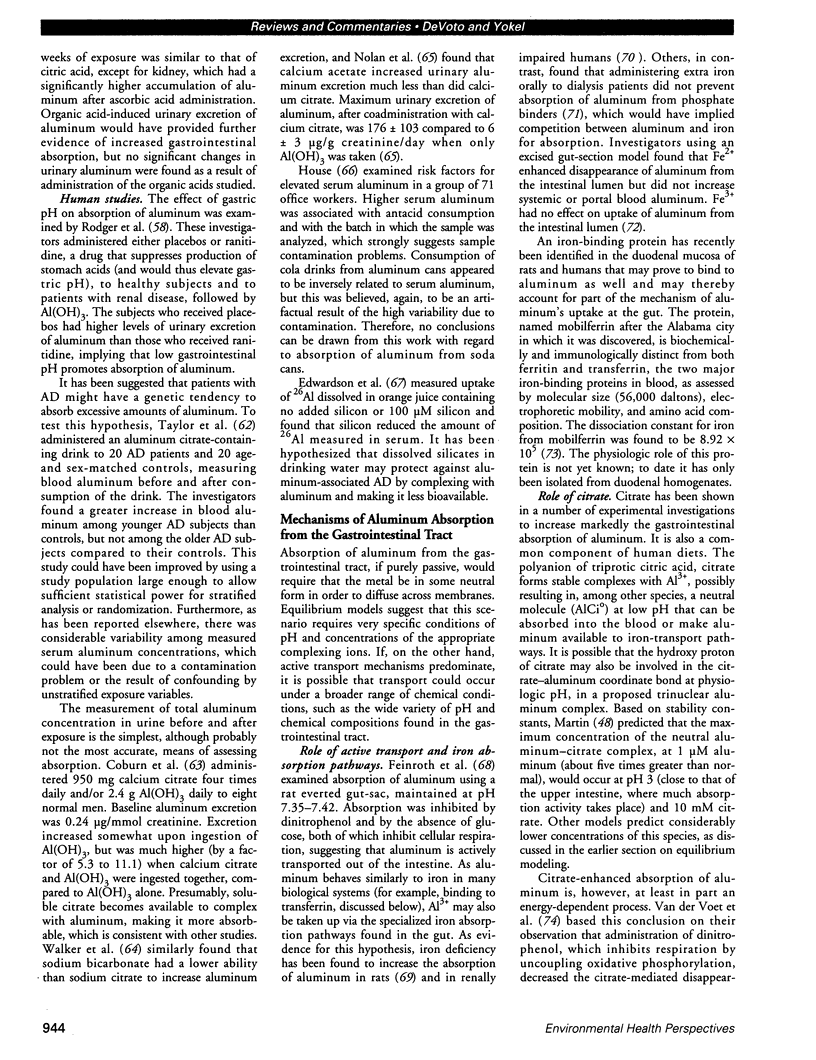
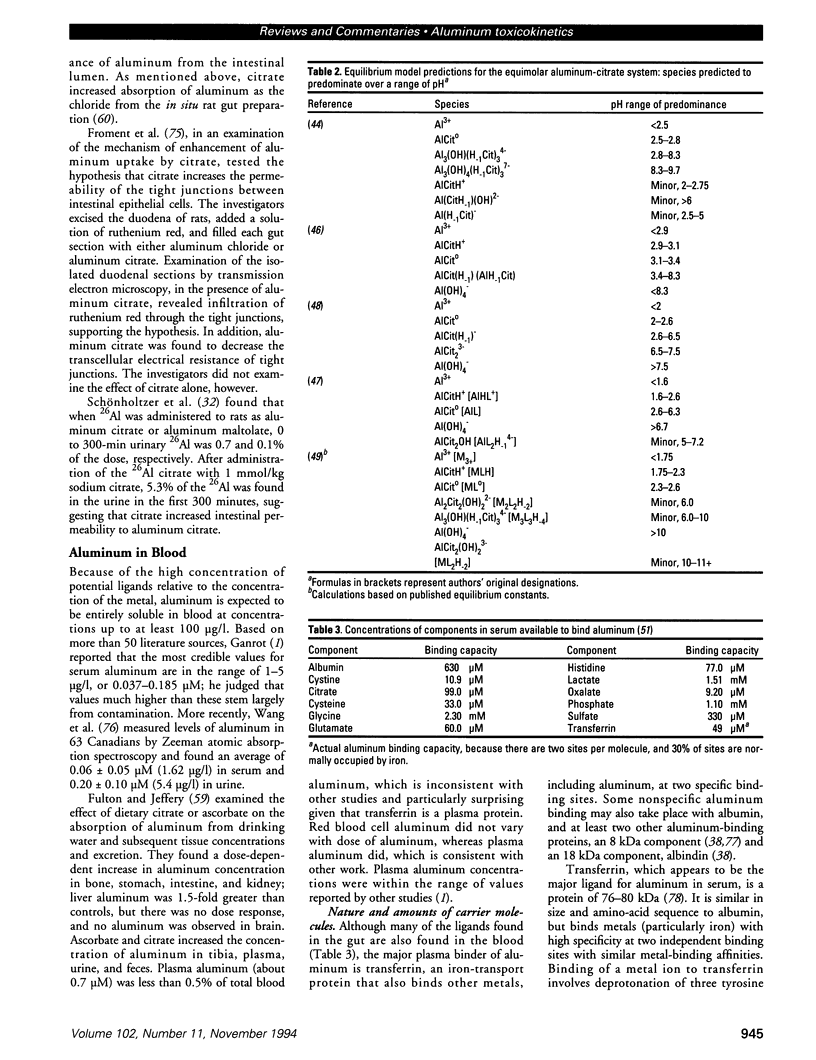
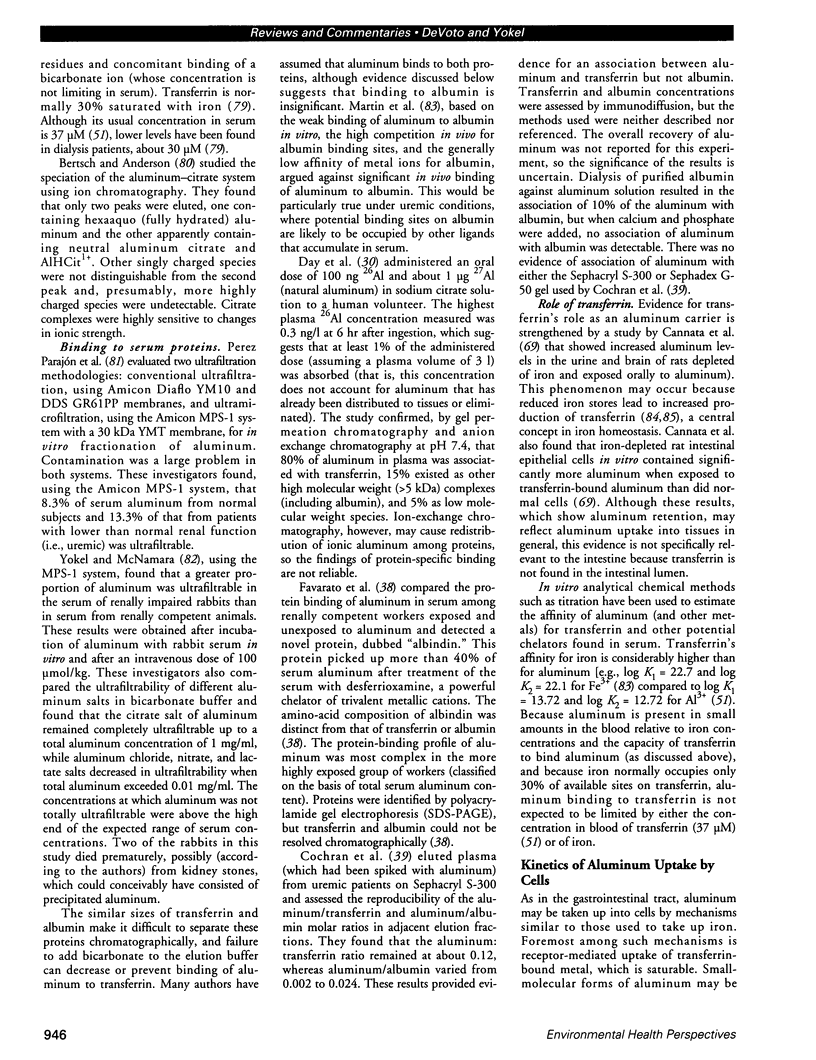
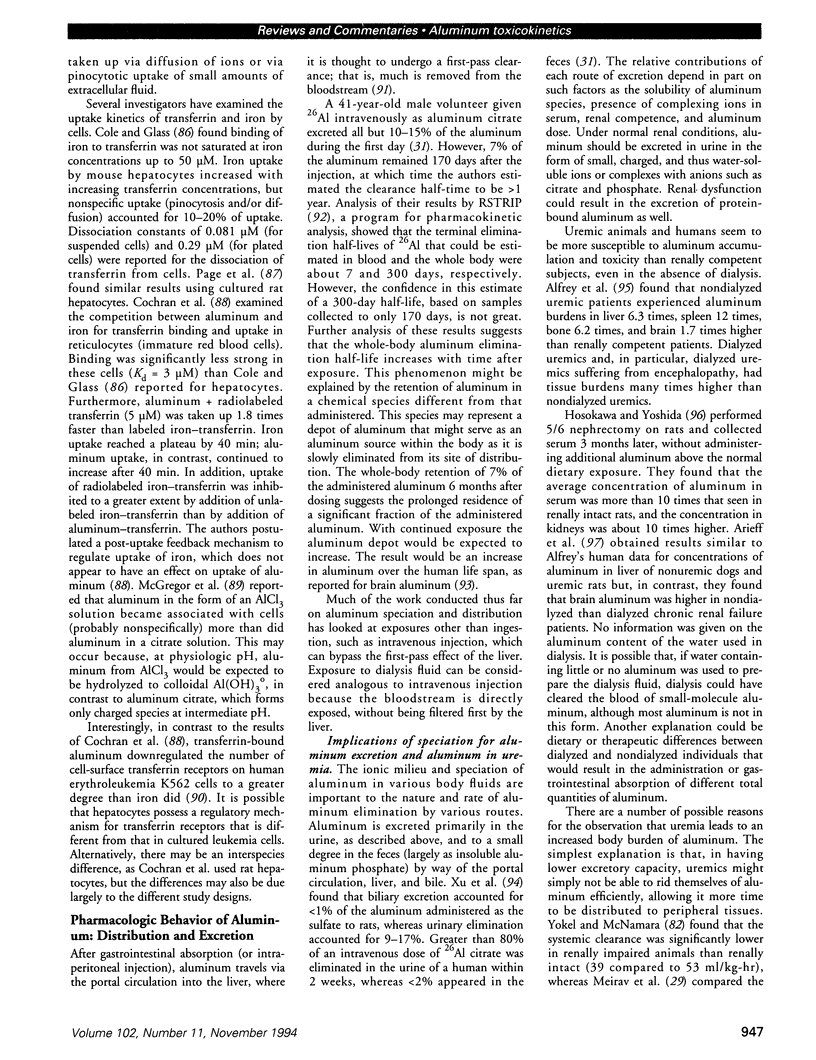
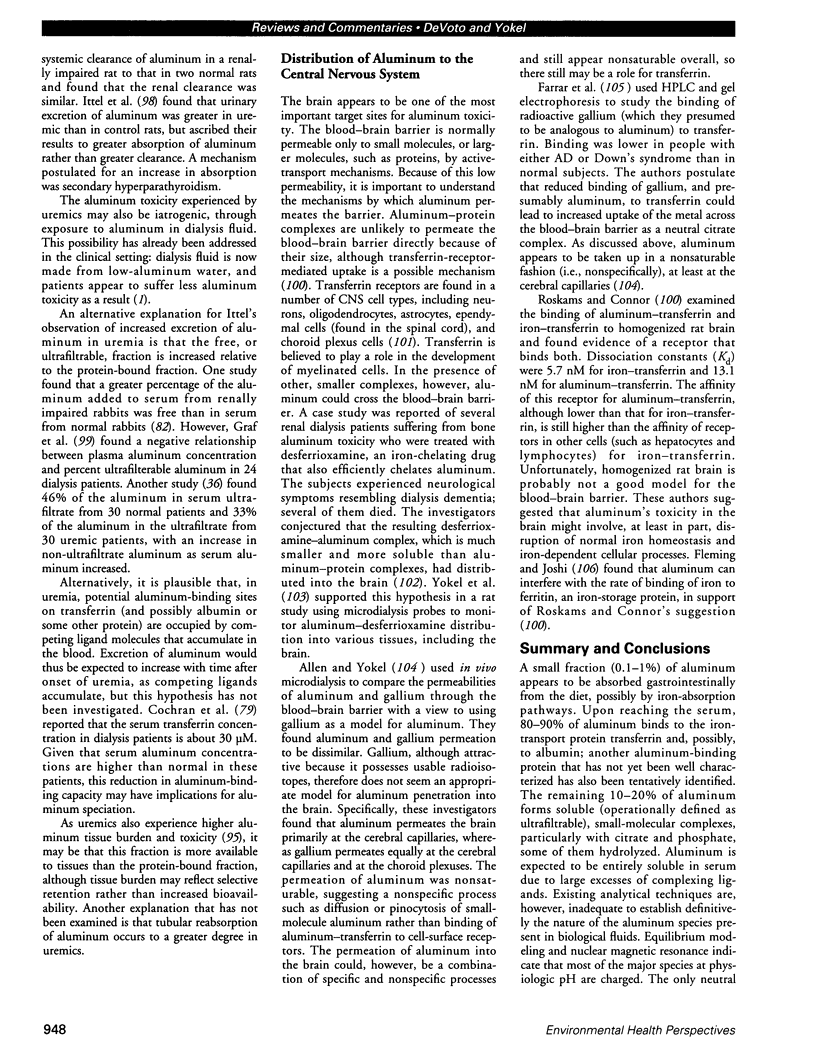
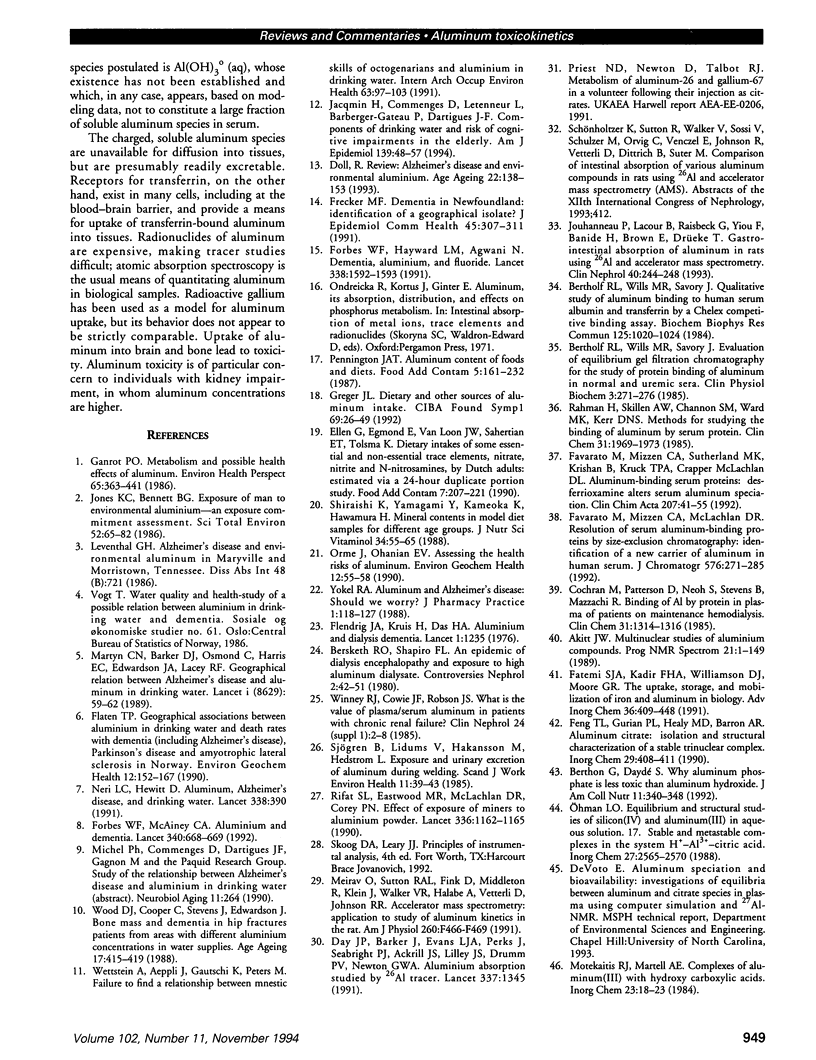

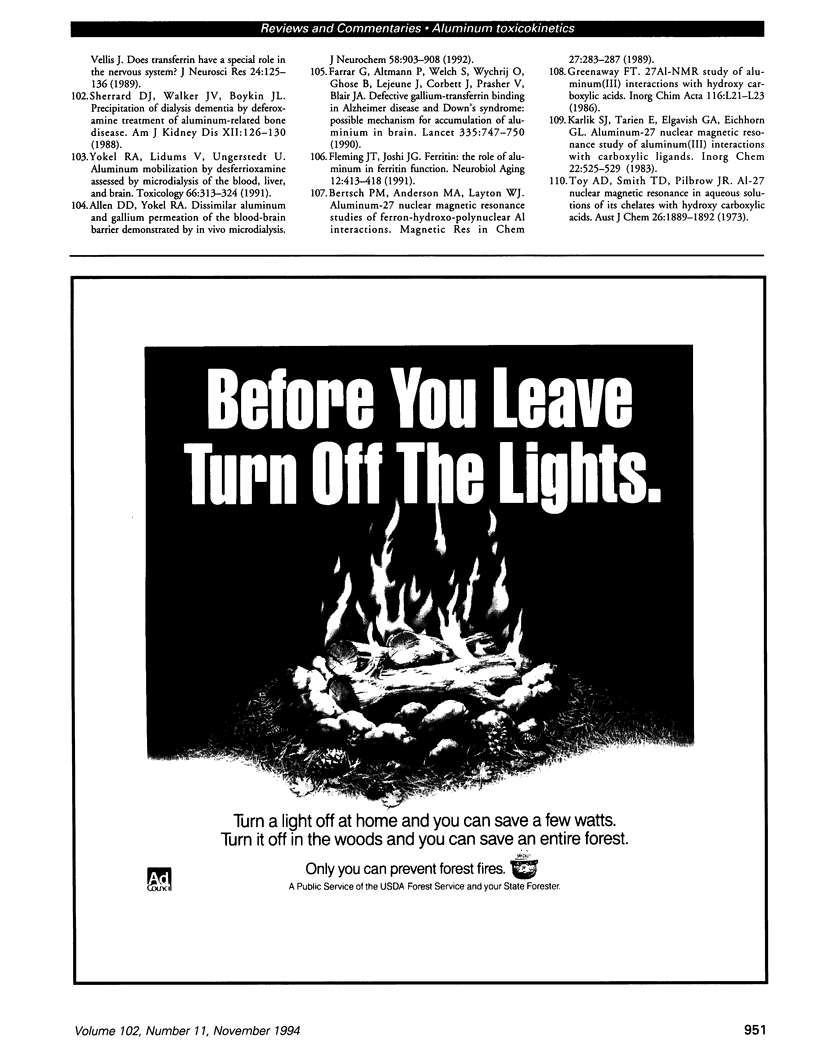
Selected References
These references are in PubMed. This may not be the complete list of references from this article.
- Aisen P., Listowsky I. Iron transport and storage proteins. Annu Rev Biochem. 1980;49:357–393. doi: 10.1146/annurev.bi.49.070180.002041. [DOI] [PubMed] [Google Scholar]
- Alfrey A. C., Hegg A., Craswell P. Metabolism and toxicity of aluminum in renal failure. Am J Clin Nutr. 1980 Jul;33(7):1509–1516. doi: 10.1093/ajcn/33.7.1509. [DOI] [PubMed] [Google Scholar]
- Allen D. D., Yokel R. A. Dissimilar aluminum and gallium permeation of the blood-brain barrier demonstrated by in vivo microdialysis. J Neurochem. 1992 Mar;58(3):903–908. doi: 10.1111/j.1471-4159.1992.tb09342.x. [DOI] [PubMed] [Google Scholar]
- Arieff A. I., Cooper J. D., Armstrong D., Lazarowitz V. C. Dementia, renal failure, and brain aluminum. Ann Intern Med. 1979 May;90(5):741–747. doi: 10.7326/0003-4819-90-5-741. [DOI] [PubMed] [Google Scholar]
- Bertholf R. L., Wills M. R., Savory J. Evaluation of equilibrium gel filtration chromatography for the study of protein binding of aluminum in normal and uremic sera. Clin Physiol Biochem. 1985;3(5):271–276. [PubMed] [Google Scholar]
- Bertholf R. L., Wills M. R., Savory J. Quantitative study of aluminum binding to human serum albumin and transferrin by a chelex competitive binding assay. Biochem Biophys Res Commun. 1984 Dec 28;125(3):1020–1024. doi: 10.1016/0006-291x(84)91385-8. [DOI] [PubMed] [Google Scholar]
- Berthon G., Daydé S. Why aluminum phosphate is less toxic than aluminum hydroxide. J Am Coll Nutr. 1992 Jun;11(3):340–348. doi: 10.1080/07315724.1992.10718236. [DOI] [PubMed] [Google Scholar]
- Bertsch P. M., Anderson M. A. Speciation of aluminum in aqueous solutions using ion chromatography. Anal Chem. 1989 Mar 15;61(6):535–539. doi: 10.1021/ac00181a007. [DOI] [PubMed] [Google Scholar]
- Cannata J. B., Fernández-Soto I., Fernández-Menendez M. J., Fernández-Martín J. L., McGregor S. J., Brock J. H., Halls D. Role of iron metabolism in absorption and cellular uptake of aluminum. Kidney Int. 1991 Apr;39(4):799–803. doi: 10.1038/ki.1991.98. [DOI] [PubMed] [Google Scholar]
- Coburn J. W., Mischel M. G., Goodman W. G., Salusky I. B. Calcium citrate markedly enhances aluminum absorption from aluminum hydroxide. Am J Kidney Dis. 1991 Jun;17(6):708–711. doi: 10.1016/s0272-6386(12)80356-8. [DOI] [PubMed] [Google Scholar]
- Cochran M., Chawtur V., Jones M. E., Marshall E. A. Iron uptake by human reticulocytes at physiologic and sub-physiologic concentrations of iron transferrin: the effect of interaction with aluminum transferrin. Blood. 1991 Jun 1;77(11):2347–2353. [PubMed] [Google Scholar]
- Cochran M., Coates J., Neoh S. The competitive equilibrium between aluminium and ferric ions for the binding sites of transferrin. FEBS Lett. 1984 Oct 15;176(1):129–132. doi: 10.1016/0014-5793(84)80926-6. [DOI] [PubMed] [Google Scholar]
- Cochran M., Patterson D., Neoh S., Stevens B., Mazzachi R. Binding of Al by protein in plasma of patients on maintenance hemodialysis. Clin Chem. 1985 Aug;31(8):1314–1316. [PubMed] [Google Scholar]
- Cole E. S., Glass J. Transferrin binding and iron uptake in mouse hepatocytes. Biochim Biophys Acta. 1983 Feb 16;762(1):102–110. doi: 10.1016/0167-4889(83)90122-2. [DOI] [PubMed] [Google Scholar]
- Conrad M. E., Umbreit J. N., Moore E. G., Rodning C. R. Newly identified iron-binding protein in human duodenal mucosa. Blood. 1992 Jan 1;79(1):244–247. [PubMed] [Google Scholar]
- Day J. P., Barker J., Evans L. J., Perks J., Seabright P. J., Ackrill P., Lilley J. S., Drumm P. V., Newton G. W. Aluminum absorption studied by 26Al tracer. Lancet. 1991 Jun 1;337(8753):1345–1345. doi: 10.1016/0140-6736(91)93016-3. [DOI] [PubMed] [Google Scholar]
- Daydé S., Filella M., Berthon G. Aluminum speciation studies in biological fluids. Part 3. Quantitative investigation of aluminum-phosphate complexes and assessment of their potential significance in vivo. J Inorg Biochem. 1990 Mar;38(3):241–259. doi: 10.1016/0162-0134(90)84016-i. [DOI] [PubMed] [Google Scholar]
- Doll R. Review: Alzheimer's disease and environmental aluminium. Age Ageing. 1993 Mar;22(2):138–153. doi: 10.1093/ageing/22.2.138. [DOI] [PubMed] [Google Scholar]
- Domingo J. L., Gomez M., Llobet J. M., Corbella J. Influence of some dietary constituents on aluminum absorption and retention in rats. Kidney Int. 1991 Apr;39(4):598–601. doi: 10.1038/ki.1991.70. [DOI] [PubMed] [Google Scholar]
- Edwardson J. A., Moore P. B., Ferrier I. N., Lilley J. S., Newton G. W., Barker J., Templar J., Day J. P. Effect of silicon on gastrointestinal absorption of aluminium. Lancet. 1993 Jul 24;342(8865):211–212. doi: 10.1016/0140-6736(93)92301-9. [DOI] [PubMed] [Google Scholar]
- Elinder C. G., Ahrengart L., Lidums V., Pettersson E., Sjögren B. Evidence of aluminium accumulation in aluminium welders. Br J Ind Med. 1991 Nov;48(11):735–738. doi: 10.1136/oem.48.11.735. [DOI] [PMC free article] [PubMed] [Google Scholar]
- Ellen G., Egmond E., Van Loon J. W., Sahertian E. T., Tolsma K. Dietary intakes of some essential and non-essential trace elements, nitrate, nitrite and N-nitrosamines, by Dutch adults: estimated via a 24-hour duplicate portion study. Food Addit Contam. 1990 Mar-Apr;7(2):207–221. doi: 10.1080/02652039009373885. [DOI] [PubMed] [Google Scholar]
- Espinosa de los Monteros A., Peña L. A., de Vellis J. Does transferrin have a special role in the nervous system? J Neurosci Res. 1989 Oct;24(2):125–136. doi: 10.1002/jnr.490240202. [DOI] [PubMed] [Google Scholar]
- Farrar G., Altmann P., Welch S., Wychrij O., Ghose B., Lejeune J., Corbett J., Prasher V., Blair J. A. Defective gallium-transferrin binding in Alzheimer disease and Down syndrome: possible mechanism for accumulation of aluminium in brain. Lancet. 1990 Mar 31;335(8692):747–750. doi: 10.1016/0140-6736(90)90868-6. [DOI] [PubMed] [Google Scholar]
- Favarato M., Mizzen C. A., McLachlan D. R. Resolution of serum aluminum-binding proteins by size-exclusion chromatography: identification of a new carrier of aluminum in human serum. J Chromatogr. 1992 May 8;576(2):271–285. doi: 10.1016/0378-4347(92)80201-z. [DOI] [PubMed] [Google Scholar]
- Favarato M., Mizzen C. A., Sutherland M. K., Krishnan B., Kruck T. P., McLachlan D. R. Aluminum-binding serum proteins: desferrioxamine alters serum aluminum speciation. Clin Chim Acta. 1992 Apr 30;207(1-2):41–55. doi: 10.1016/0009-8981(92)90149-k. [DOI] [PubMed] [Google Scholar]
- Feinroth M., Feinroth M. V., Berlyne G. M. Aluminum absorption in the rat everted gut sac. Miner Electrolyte Metab. 1982 Jul;8(1):29–35. [PubMed] [Google Scholar]
- Fleming J. T., Joshi J. G. Ferritin: the role of aluminum in ferritin function. Neurobiol Aging. 1991 Sep-Oct;12(5):413–418. doi: 10.1016/0197-4580(91)90066-s. [DOI] [PubMed] [Google Scholar]
- Flendrig J. A., Kruis H., Das H. A. Letter: Aluminum and dialysis dementia. Lancet. 1976 Jun 5;1(7971):1235–1235. doi: 10.1016/s0140-6736(76)92177-2. [DOI] [PubMed] [Google Scholar]
- Forbes W. F., Hayward L. M., Agwani N. Dementia, aluminium, and fluoride. Lancet. 1991 Dec 21;338(8782-8783):1592–1593. doi: 10.1016/0140-6736(91)92411-t. [DOI] [PubMed] [Google Scholar]
- Forbes W. F., McAiney C. A. Aluminum and dementia. Lancet. 1992 Sep 12;340(8820):668–669. doi: 10.1016/0140-6736(92)92198-o. [DOI] [PubMed] [Google Scholar]
- Frecker M. F. Dementia in Newfoundland: identification of a geographical isolate? J Epidemiol Community Health. 1991 Dec;45(4):307–311. doi: 10.1136/jech.45.4.307. [DOI] [PMC free article] [PubMed] [Google Scholar]
- Froment D. P., Molitoris B. A., Buddington B., Miller N., Alfrey A. C. Site and mechanism of enhanced gastrointestinal absorption of aluminum by citrate. Kidney Int. 1989 Dec;36(6):978–984. doi: 10.1038/ki.1989.290. [DOI] [PubMed] [Google Scholar]
- Fulton B., Jeffery E. H. Absorption and retention of aluminum from drinking water. 1. Effect of citric and ascorbic acids on aluminum tissue levels in rabbits. Fundam Appl Toxicol. 1990 May;14(4):788–796. doi: 10.1016/0272-0590(90)90303-2. [DOI] [PubMed] [Google Scholar]
- Ganrot P. O. Metabolism and possible health effects of aluminum. Environ Health Perspect. 1986 Mar;65:363–441. doi: 10.1289/ehp.8665363. [DOI] [PMC free article] [PubMed] [Google Scholar]
- Harris W. R. Equilibrium model for speciation of aluminum in serum. Clin Chem. 1992 Sep;38(9):1809–1818. [PubMed] [Google Scholar]
- Hosokawa S., Yoshida O. The relationship between calcium content and aluminum and silicon content in uraemic rats. Int Urol Nephrol. 1989;21(4):435–444. doi: 10.1007/BF02559641. [DOI] [PubMed] [Google Scholar]
- House R. A. Factors affecting plasma aluminum concentrations in nonexposed workers. J Occup Med. 1992 Oct;34(10):1013–1017. [PubMed] [Google Scholar]
- Huang J. Y., Huang C. C., Lim P. S., Wu M. S., Leu M. L. Effect of body iron stores on serum aluminum level in hemodialysis patients. Nephron. 1992;61(2):158–162. doi: 10.1159/000186864. [DOI] [PubMed] [Google Scholar]
- Ittel T. H. Determinants of gastrointestinal absorption and distribution of aluminium in health and uraemia. Nephrol Dial Transplant. 1993;8 (Suppl 1):17–24. doi: 10.1093/ndt/8.supp1.17. [DOI] [PubMed] [Google Scholar]
- Jacqmin H., Commenges D., Letenneur L., Barberger-Gateau P., Dartigues J. F. Components of drinking water and risk of cognitive impairment in the elderly. Am J Epidemiol. 1994 Jan 1;139(1):48–57. doi: 10.1093/oxfordjournals.aje.a116934. [DOI] [PubMed] [Google Scholar]
- Jones K. C., Bennett B. G. Exposure of man to environmental aluminium--an exposure commitment assessment. Sci Total Environ. 1986 Jun;52(1-2):65–82. doi: 10.1016/0048-9697(86)90105-1. [DOI] [PubMed] [Google Scholar]
- Jouhanneau P., Lacour B., Raisbeck G., Yiou F., Banide H., Brown E., Drüeke T. Gastrointestinal absorption of aluminum in rats using 26Al and accelerator mass spectrometry. Clin Nephrol. 1993 Oct;40(4):244–248. [PubMed] [Google Scholar]
- Klausner R. D. From receptors to genes--insights from molecular iron metabolism. Clin Res. 1988 Sep;36(5):494–500. [PubMed] [Google Scholar]
- Ljunggren K. G., Lidums V., Sjögren B. Blood and urine concentrations of aluminium among workers exposed to aluminium flake powders. Br J Ind Med. 1991 Feb;48(2):106–109. doi: 10.1136/oem.48.2.106. [DOI] [PMC free article] [PubMed] [Google Scholar]
- Martin R. B., Savory J., Brown S., Bertholf R. L., Wills M. R. Transferrin binding of Al3+ and Fe3+. Clin Chem. 1987 Mar;33(3):405–407. [PubMed] [Google Scholar]
- Martin R. B. The chemistry of aluminum as related to biology and medicine. Clin Chem. 1986 Oct;32(10):1797–1806. [PubMed] [Google Scholar]
- Martyn C. N., Barker D. J., Osmond C., Harris E. C., Edwardson J. A., Lacey R. F. Geographical relation between Alzheimer's disease and aluminum in drinking water. Lancet. 1989 Jan 14;1(8629):59–62. [PubMed] [Google Scholar]
- McGregor S. J., Naves M. L., Birly A. K., Russell N. H., Halls D., Junor B. J., Brock J. H. Interaction of aluminium and gallium with human lymphocytes: the role of transferrin. Biochim Biophys Acta. 1991 Nov 12;1095(3):196–200. doi: 10.1016/0167-4889(91)90099-j. [DOI] [PubMed] [Google Scholar]
- McGregor S. J., Naves M. L., Oria R., Vass J. K., Brock J. H. Effect of aluminium on iron uptake and transferrin-receptor expression by human erythroleukaemia K562 cells. Biochem J. 1990 Dec 1;272(2):377–382. doi: 10.1042/bj2720377. [DOI] [PMC free article] [PubMed] [Google Scholar]
- Meirav O., Sutton R. A., Fink D., Middleton R., Klein J., Walker V. R., Halabe A., Vetterli D., Johnson R. R. Accelerator mass spectrometry: application to study of aluminum kinetics in the rat. Am J Physiol. 1991 Mar;260(3 Pt 2):F466–F469. doi: 10.1152/ajprenal.1991.260.3.F466. [DOI] [PubMed] [Google Scholar]
- Neri L. C., Hewitt D. Aluminium, Alzheimer's disease, and drinking water. Lancet. 1991 Aug 10;338(8763):390–390. doi: 10.1016/0140-6736(91)90531-s. [DOI] [PubMed] [Google Scholar]
- Nolan C. R., Califano J. R., Butzin C. A. Influence of calcium acetate or calcium citrate on intestinal aluminum absorption. Kidney Int. 1990 Nov;38(5):937–941. doi: 10.1038/ki.1990.294. [DOI] [PubMed] [Google Scholar]
- O'Connell K. A., Hamera E. K., Knapp T. M., Cassmeyer V. L., Eaks G. A., Fox M. A. Symptom use and self-regulation in type II diabetes. ANS Adv Nurs Sci. 1984 Apr;6(3):19–28. doi: 10.1097/00012272-198404000-00007. [DOI] [PubMed] [Google Scholar]
- Page M. A., Baker E., Morgan E. H. Transferrin and iron uptake by rat hepatocytes in culture. Am J Physiol. 1984 Jan;246(1 Pt 1):G26–G33. doi: 10.1152/ajpgi.1984.246.1.G26. [DOI] [PubMed] [Google Scholar]
- Partridge N. A., Regnier F. E., White J. L., Hem S. L. Influence of dietary constituents on intestinal absorption of aluminum. Kidney Int. 1989 Jun;35(6):1413–1417. doi: 10.1038/ki.1989.142. [DOI] [PubMed] [Google Scholar]
- Pennington J. A. Aluminium content of foods and diets. Food Addit Contam. 1988 Apr-Jun;5(2):161–232. doi: 10.1080/02652038809373696. [DOI] [PubMed] [Google Scholar]
- Rahman H., Skillen A. W., Channon S. M., Ward M. K., Kerr D. N. Methods for studying the binding of aluminum by serum protein. Clin Chem. 1985 Dec;31(12):1969–1973. [PubMed] [Google Scholar]
- Rifat S. L., Eastwood M. R., McLachlan D. R., Corey P. N. Effect of exposure of miners to aluminium powder. Lancet. 1990 Nov 10;336(8724):1162–1165. doi: 10.1016/0140-6736(90)92775-d. [DOI] [PubMed] [Google Scholar]
- Rodger R. S., Muralikrishna G. S., Halls D. J., Henderson J. B., Forrest J. A., Macdougall A. I., Fell G. S. Ranitidine suppresses aluminium absorption in man. Clin Sci (Lond) 1991 May;80(5):505–508. doi: 10.1042/cs0800505. [DOI] [PubMed] [Google Scholar]
- Roskams A. J., Connor J. R. Aluminum access to the brain: a role for transferrin and its receptor. Proc Natl Acad Sci U S A. 1990 Nov;87(22):9024–9027. doi: 10.1073/pnas.87.22.9024. [DOI] [PMC free article] [PubMed] [Google Scholar]
- Röllin H. B., Theodorou P., Kilroe-Smith T. A. Deposition of aluminium in tissues of rabbits exposed to inhalation of low concentrations of Al2O3 dust. Br J Ind Med. 1991 Jun;48(6):389–391. doi: 10.1136/oem.48.6.389. [DOI] [PMC free article] [PubMed] [Google Scholar]
- Röllin H. B., Theodorou P., Kilroe-Smith T. A. The effect of exposure to aluminium on concentrations of essential metals in serum of foundry workers. Br J Ind Med. 1991 Apr;48(4):243–246. doi: 10.1136/oem.48.4.243. [DOI] [PMC free article] [PubMed] [Google Scholar]
- Sherrard D. J., Walker J. V., Boykin J. L. Precipitation of dialysis dementia by deferoxamine treatment of aluminum-related bone disease. Am J Kidney Dis. 1988 Aug;12(2):126–130. doi: 10.1016/s0272-6386(88)80007-6. [DOI] [PubMed] [Google Scholar]
- Shiraishi K., Yamagami Y., Kameoka K., Kawamura H. Mineral contents in model diet samples for different age groups. J Nutr Sci Vitaminol (Tokyo) 1988 Feb;34(1):55–65. doi: 10.3177/jnsv.34.55. [DOI] [PubMed] [Google Scholar]
- Sjögren B., Elinder C. G., Lidums V., Chang G. Uptake and urinary excretion of aluminum among welders. Int Arch Occup Environ Health. 1988;60(2):77–79. doi: 10.1007/BF00381484. [DOI] [PubMed] [Google Scholar]
- Sjögren B., Lidums V., Håkansson M., Hedström L. Exposure and urinary excretion of aluminum during welding. Scand J Work Environ Health. 1985 Feb;11(1):39–43. doi: 10.5271/sjweh.2255. [DOI] [PubMed] [Google Scholar]
- Taylor G. A., Ferrier I. N., McLoughlin I. J., Fairbairn A. F., McKeith I. G., Lett D., Edwardson J. A. Gastrointestinal absorption of aluminium in Alzheimer's disease: response to aluminium citrate. Age Ageing. 1992 Mar;21(2):81–90. doi: 10.1093/ageing/21.2.81. [DOI] [PubMed] [Google Scholar]
- Van der Voet G. B., De Wolff F. A. The effect of di- and trivalent iron on the intestinal absorption of aluminum in rats. Toxicol Appl Pharmacol. 1987 Sep 15;90(2):190–197. doi: 10.1016/0041-008x(87)90326-7. [DOI] [PubMed] [Google Scholar]
- Venturini M., Berthon G. Aluminum speciation studies in biological fluids. Part 2. Quantitative investigation of aluminum-citrate complexes and appraisal of their potential significance in vivo. J Inorg Biochem. 1989 Sep;37(1):69–90. doi: 10.1016/0162-0134(89)80031-5. [DOI] [PubMed] [Google Scholar]
- Walker J. A., Sherman R. A., Cody R. P. The effect of oral bases on enteral aluminum absorption. Arch Intern Med. 1990 Oct;150(10):2037–2039. [PubMed] [Google Scholar]
- Wang S. T., Pizzolato S., Demshar H. P. Aluminum levels in normal human serum and urine as determined by Zeeman atomic absorption spectrometry. J Anal Toxicol. 1991 Mar-Apr;15(2):66–70. doi: 10.1093/jat/15.2.66. [DOI] [PubMed] [Google Scholar]
- Wettstein A., Aeppli J., Gautschi K., Peters M. Failure to find a relationship between mnestic skills of octogenarians and aluminum in drinking water. Int Arch Occup Environ Health. 1991;63(2):97–103. doi: 10.1007/BF00379071. [DOI] [PubMed] [Google Scholar]
- Wood D. J., Cooper C., Stevens J., Edwardson J. Bone mass and dementia in hip fracture patients from areas with different aluminium concentrations in water supplies. Age Ageing. 1988 Nov;17(6):415–419. doi: 10.1093/ageing/17.6.415. [DOI] [PubMed] [Google Scholar]
- Xu Z. X., Pai S. M., Melethil S. Kinetics of aluminum in rats. II: Dose-dependent urinary and biliary excretion. J Pharm Sci. 1991 Oct;80(10):946–951. doi: 10.1002/jps.2600801009. [DOI] [PubMed] [Google Scholar]
- Xu Z. X., Tang J. P., Badr M., Melethil S. Kinetics of aluminum in rats. III: Effect of route of administration. J Pharm Sci. 1992 Feb;81(2):160–163. doi: 10.1002/jps.2600810212. [DOI] [PubMed] [Google Scholar]
- Yokel R. A., Lidums V., Ungerstedt U. Aluminum mobilization by desferrioxamine assessed by microdialysis of the blood, liver and brain. Toxicology. 1991 Mar 11;66(3):313–324. doi: 10.1016/0300-483x(91)90202-c. [DOI] [PubMed] [Google Scholar]
- Yokel R. A., McNamara P. J. Influence of renal impairment, chemical form, and serum protein binding on intravenous and oral aluminum kinetics in the rabbit. Toxicol Appl Pharmacol. 1988 Aug;95(1):32–43. doi: 10.1016/s0041-008x(88)80005-x. [DOI] [PubMed] [Google Scholar]
- van der Voet G. B., van Ginkel M. F., de Wolff F. A. Intestinal absorption of aluminum in rats: stimulation by citric acid and inhibition by dinitrophenol. Toxicol Appl Pharmacol. 1989 Jun 1;99(1):90–97. doi: 10.1016/0041-008x(89)90114-2. [DOI] [PubMed] [Google Scholar]


